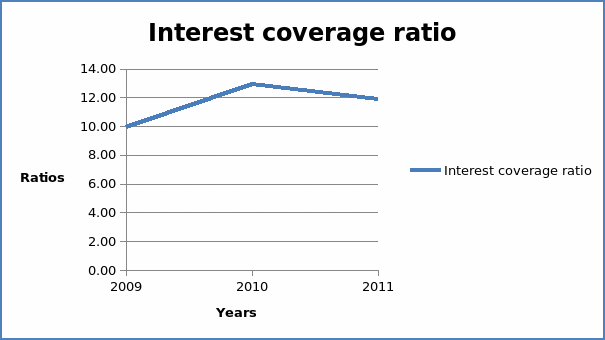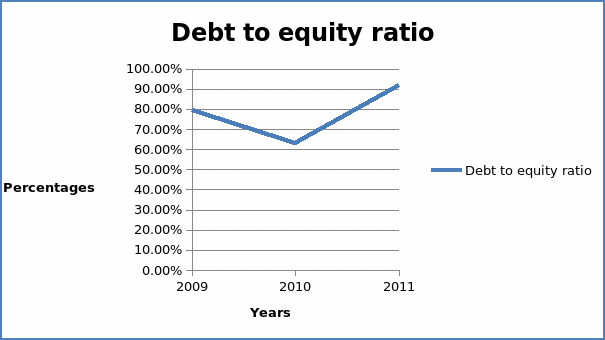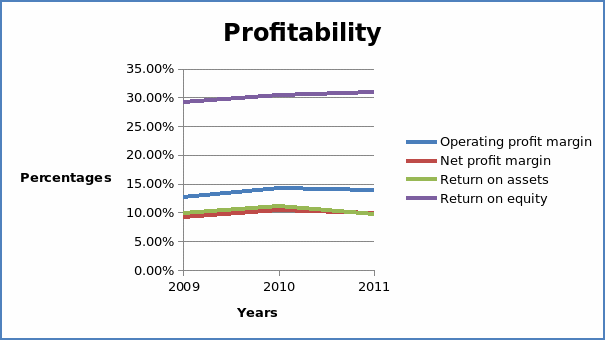Solvency and debt ratios
Solvency ratios measure the ability of the company to meet the interest obligations that arise from debts payable by the company. A commonly used solvency ratio is the interest coverage ratio. It is arrived at by dividing earnings before interest expenses and income and interest expense. The table below shows the interest coverage ratio for Unilever Group for three years
From the table, it is evident that the interest coverage ratio increased from 9.96 times in 2009 to 12.91 times in 2010. Thereafter, it declined to 11.91 times in 2011. The trend in the interest coverage ratio can be attributed to a declined in interest expense from €504 million to €491 million and an increase to €540 million. Interest coverage ratio of the company is relatively high (Unilever Group 2013a). The interest coverage ratio for Unilever is lower than that of Nestel (13.3 times). The trend in finance cost is attributed to changes in the amount of debt (ABC News Network 2013). The graph below shows the trend of the ratios.

Leverage
A company’s leverage is explained by the amount of debt financing it holds. The ratios are vital since they show the investor the extent of exposure of equity financing. A commonly used ratio is the debt to equity ratio. A high leverage ratio is not favorable since it scares away capital providers. It is because high ratios imply an increase in interest expense. This reduces the amount of income attributable to shareholders. On the other hand, very low ratios are not favorable since it shows that the management of the company are not willing to exploit the potentials of the company. A commonly used ratio is the debt to equity ratio.
The debt to equity ratio declined from 79.54% in 2009 to 63.23% in 2010. This further increased to 91.94% in 2011. This was as a result of an increase in the total amount of debt of €7,255 million in 2010 to €10,502 million in 2011. It is evident that the leverage level of the company is higher than the leverage of the competitor which is 44.46%. The leverage of the company is quite high. The trend is shown in the graph below.

Profitability
Profitability ratios give an indication of the earning capacity of an entity. The ratios measure the effectiveness of a company in meeting the profit objectives both in the long run and short run. The ratios show how well a company employs its resources to generate returns. Commonly used profitability ratios comprise of gross profit margin, operating profit margin, net profit margin, return on asset, and return on equity (Holmes & Sugden 2005). The table below summarizes profitability ratios for the company.
The operating profit margin and net profit margin for Unilever Group increased from 2009 to 2010. Thereafter, it declined in 2011. The two ratios for Unilever are lower than those of Nestle. This could be an indication that the management of the company is not efficient in managing the cost of running the business. Return on assets and return on equity for Unilever Group was higher than those of Nestle Group (Unilever Group 2013b). It is an indication that management of Unilever is efficient in managing the resources of the company so as to generate sales and net income. The trend of the ratios is shown below.

Working capital management
Efficiency ratios focus on the internal operations of the company. These ratios show the level of activity in a company, that is, how well a company manages resources to generate sales. Commonly used turnover ratios are asset turnover ratios, stock turnover ratios, debtor collection period, and creditor payment period (Holmes & Sugden 2005). A summary of the turnover ratios is shown in the table below.
The accounts payable and accounts receivable for Unilever Group were increasing over the years. The total asset turnover for the company remained fairly stable during the three year period. Further, stock turnover and debtor collection period increased through the three year period. The efficiency ratios for Unilever Group were higher than the ratios for Nestle. This implies that the efficiency of Unilever Group is higher than the efficiency of Nestle (ABC News Network 2013).
Based on the profitability and efficiency ratios, the financial position of Unilever Group is better than that of its key competitor Nestle. However, Unilever is highly levered and there is the need to reduce the leverage level of the Group.
References
ABC News Network 2013, Unilever NV (UN), Web.
Holmes, G & Sugden, A 2005 Interpreting Company Reports, McGraw-Hill, New York.
Unilever Group 2013a, 2011 Annual Report, Web.
Unilever Group 2013b, 2010 Annual Report, Web.